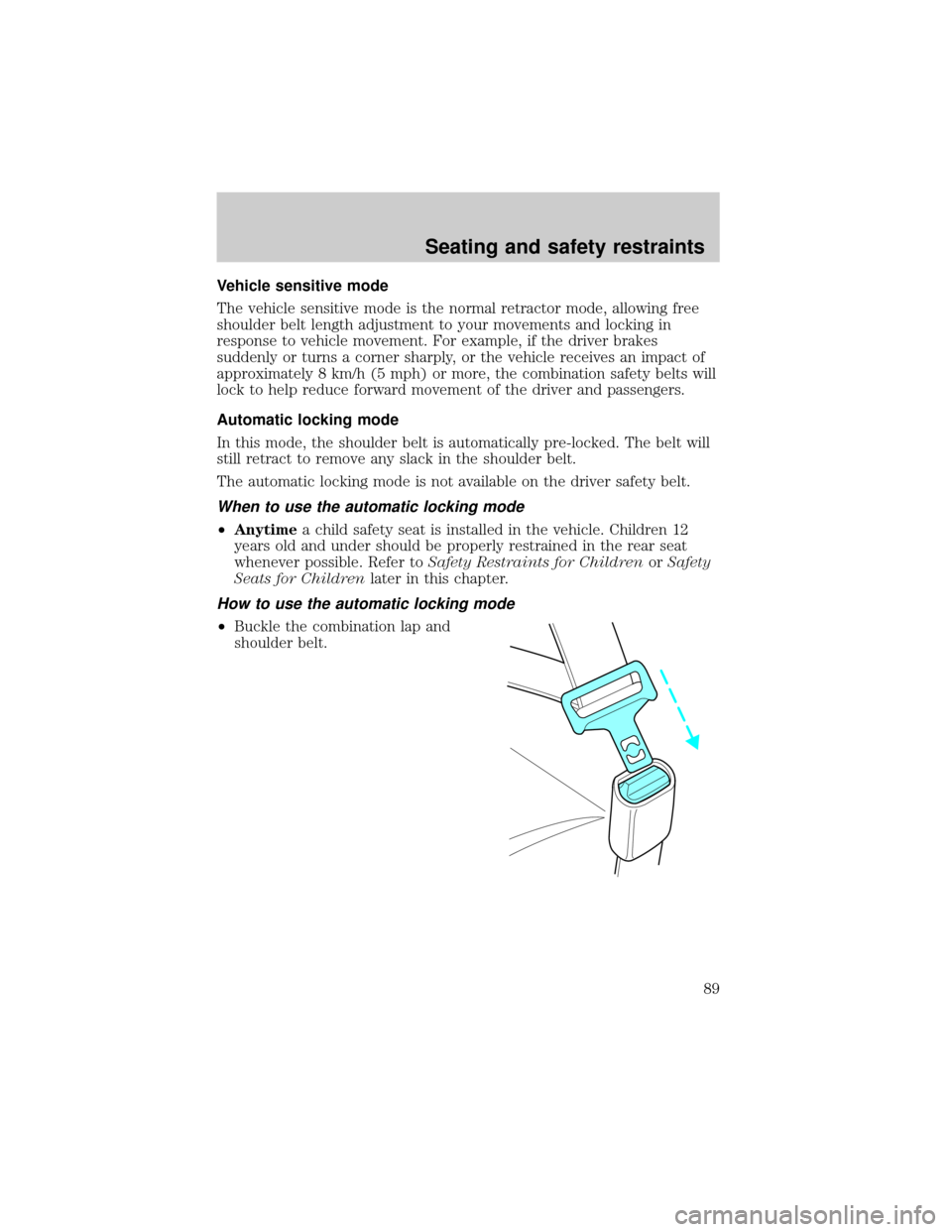Page 89 of 224

Vehicle sensitive mode
The vehicle sensitive mode is the normal retractor mode, allowing free
shoulder belt length adjustment to your movements and locking in
response to vehicle movement. For example, if the driver brakes
suddenly or turns a corner sharply, or the vehicle receives an impact of
approximately 8 km/h (5 mph) or more, the combination safety belts will
lock to help reduce forward movement of the driver and passengers.
Automatic locking mode
In this mode, the shoulder belt is automatically pre-locked. The belt will
still retract to remove any slack in the shoulder belt.
The automatic locking mode is not available on the driver safety belt.
When to use the automatic locking mode
²Anytimea child safety seat is installed in the vehicle. Children 12
years old and under should be properly restrained in the rear seat
whenever possible. Refer toSafety Restraints for ChildrenorSafety
Seats for Childrenlater in this chapter.
How to use the automatic locking mode
²Buckle the combination lap and
shoulder belt.
Seating and safety restraints
89
Page 91 of 224
Front safety belt height adjustment
Your vehicle has safety belt height
adjustments for the driver and front
passenger. Adjust the height of the
shoulder belt so the belt rests
across the middle of your shoulder.
To lower the shoulder belt height,
push the button and slide the height
adjuster down. To raise the height
of the shoulder belt, slide the height
adjuster up. Pull down on the height
adjuster to make sure it is locked in
place.
Position the shoulder belt
height adjusters so that the
belt rests across the middle of
your shoulder. Failure to adjust
the safety belt properly could
reduce the effectiveness of the
seat belt and increase the risk of
injury in a collision.
Lap belts
Adjusting the front center seat lap belt (if equipped)
The lap belt should fit snugly and as low as possible around the
hips, not across the waist.
Seating and safety restraints
91
Page 192 of 224

Function Trade Number
Luggage compartment lamp (decklid ajar) 912
Side marker (front) 194 AK (amber)
Side marker (rear) 916
Stoplamp and tail lamp 3157K
Redundant turn lamp (rear) 3157K
Glovebox lamp 194
Ash receptacle 1445
Ash tray (rear) 37
Cigar lighter (console) 1893
Door mounted lamp (front) 214-2
Illuminated visor mirror 74
Overhead console reading lamp (without
moon roof)912
Passenger assist handle (rear seat) 211-2
All replacement bulbs are clear in color except where noted.
To replace all instrument panel lights - see your dealer.
AIMING THE HEADLAMPS
Your vehicle is equipped with a Vehicle Headlamp Aim Device (VHAD)
on each headlamp. Each headlamp may be properly aimed in the vertical
(up/down) and the horizontal (left/right) directions using your VHAD
system. The headlamps on your vehicle are properly aimed at the
assembly plant.
A bubble (vertical indicator) that is not centered between the two red
lines does not necessarily indicate out-of-aim headlamps. If your vehicle
is not positioned on a level surface, the slope will be included in the
vertical indication. Therefore, vertical and horizontal headlamp
adjustment should be performed only when the beam direction appears
to be incorrect.
You will need one 4 mm wrench or socket to make the adjustments.
If the vehicle has been in an accident, the vehicle's front structure
should be properly aligned before aiming the headlamps.
Maintenance and care
192
Page 219 of 224

instrument panel ....................198
interior .....................................199
mirrors .....................................196
plastic parts ............................196
safety belts ..............................199
washing ....................................195
waxing .....................................195
wheels ......................................196
windows ..................................199
wiper blades ............................197
woodtone trim ........................198
Climate control (see Air
conditioning or Heating) ............27
Clock ............................................33
Compass, electronic ....................61
calibration .................................62
set zone adjustment .................61
Console ..................................68±69
Controls
power seat .................................84
steering column ........................51
Coolant
checking and adding ..............157
refill capacities ................161, 200
specifications ..................201±202
Cruise control
(see Speed control) ....................51
Customer Assistance ................132
Ford accessories
for your vehicle ......................212
Ford Extended
Service Plan ............................205
Getting assistance outside
the U.S. and Canada ..............211
Getting roadside assistance ...132
Getting the
service you need ....................205
Ordering additional
owner's literature ...................215The Dispute
Settlement Board ...................208
Utilizing the Mediation/
Arbitration Program ...............211
D
Daytime running lamps
(see Lamps) ................................25
Defrost
rear window ..............................33
Dipstick
automatic
transmission fluid ...................163
engine oil .................................153
Doors
lubricant specifications ..........201
Driving under special
conditions
through water .........................126
E
Electronic message center .........14
Emergencies, roadside
jump-starting ..........................144
Emission control system ..........184
Engine ........................................202
check engine/
service engine soon light ...........8
cleaning ...................................197
coolant .....................................157
idle speed control ...................165
lubrication
specifications ..................201±202
refill capacities ........................200
service points ..........................152
starting after a collision .........133
Engine block heater .................114
Index
219